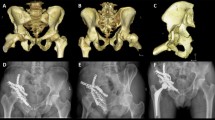Abstract
The objective of this study was to assess the outcome of operations on acetabular fractures from a developing country in the presence of locally available facilities. Sixty-three acetabular fractures were assessed at an average follow up of 52.94 months after operation. Twenty-six patients operated upon in the first three years and 37 operated thereafter were separately studied to discover the effect of the learning curve. Regarding the fractures, 47 of 63 (74.6%) had excellent/good results (Harris Hip Score>80). The complications included broken drill bit in eight patients (12.69%), deep infection and heterotopic ossification in five patients (7.93%), avascular necrosis and sciatic nerve palsy in two patients (3.17%) and implant failure in one patient (1.58%). The results collected during the learning curve were inferior in the complex fractures (p value<0.001). Complications were common in patients opting for local implants and in those operated after over 2 weeks delay.
Résumé
Le but de ce travail est d’évaluer le traitement des fractures de l’accétabulum dans un pays développé. Matériel et méthode : 63 fractures de l’accétabulum ont été suivies en moyenne pendant 52,94 mois. 26 patients ont été opérés dans les trois premières années de notre expérience et les 37 autres patients opérés trois ans après que nous ayons commencé ce type de traitement, ceci afin d’évaluer de façon séparée les effets de notre courbe d’apprentissage. 47 sur 63 (74,6%) ont eu un excellent/bon résultat avec un score de Harris supérieur à 80. Les complications ont été les suivantes : 8 fractures de mèches (12,69%), 5 infections profondes (7,93%) et 7 ossifications hétérotypiques (7,93%), 2 nécroses de la tête fémorale et 2 paralysies sciatiques (3,17%) une dans chaque groupe. Enfin, un débricolage chez un patient (1,58%). Les résultats selon la courbe d’apprentissage sont moins bons dans des fractures complexes (p < 0.001) en début de pratique. Les complications sont plus habituelles chez les patients ayant bénéficié de la mise en place d’implants ou chez ceux opérés après 2 semaines de délai.



Similar content being viewed by others
References
Bosse MJ, Poka A, Reinert CM, Ellwanger F, Slawson R, McDevitt ER (1988) Heterotopic ossification as a complication of acetabular fracture. Prophylaxis with low-dose irradiation. J Bone Joint Surg Am 70(8):1231–1237
Brooker AF, Bowerman JW, Robinson RA, Riley LH (1973) Ectopic ossification following total hip replacement. Incidence and a method of classification. J Bone Joint Surg Am 55(8):1629–1632
Brueton RN (1993) A review of 40 acetabular fractures. The importance of early surgery. Injury 24(3):171–174
Deo SD, Tavares SP, Pandey RK, El-Saied G, Willett KM, Worlock PH (2001) Operative management of acetabular fractures in Oxford. Injury 32:581–586
Fica G, Cordova M, Guzman L, Schweitzer D (1998) Open reduction and internal fixation of acetabular fractures. Int Orthop 22(6):348–351
Ghalambor N, Matta JM, Bernstein L (1994) Heterotopic ossification following operative treatment of acetabular fracture: an analysis of risk factors. Clin Orthop Relat Res 305:96–105
Harris WH (1969) Traumatic arthritis of the hip after dislocation and acetabular fractures: treatment by mold arthroplasty. An end-result study using a new method of result evaluation. J Bone Joint Surg Am 51(4):737–755
Heeg M, Klasen HJ, Visser JD (1990) Operative treatment for acetabular fractures. J Bone Joint Surg Br 72(3):383–386
Helfet DL, Schmeling GJ (1994) Management of complex acetabular fractures through single nonextensile exposures. Clin Orthop Relat Res 305:58–68
Hesp WL, Goris RJ (1988) Conservative treatment of fractures of the acetabulum. Results after long-term follow-up. Acta Chirurg Belg 88:27–32
Holdsworth FW (1948) Dislocation and fracture-dislocation of the pelvis. J Bone Joint Surg Br 30B:461–466
Kaempffe FA, Bone LB, Border JR (1991) Open reduction and internal fixation of acetabular fractures: heterotopic ossification and other complications of treatment. J Orthop Trauma 5(4):439–445
Kebaish AS, Roy A, Rennie W (1991) Displaced acetabular fractures: long-term follow-up. J Trauma 31(11):1539–1542
Kumar A, Shah NA, Kershaw SA, Clayson AD (2005) Operative management of acetabular fractures. A review of 73 fractures. Injury 36:605–612
Latenser BA, Gentilello LM, Tarver AA, Thalgott JS, Batdorf JW (1991) Improved outcome with early fixation of skeletally unstable pelvic fractures. J Trauma 31(1):28–31
Letournel E (1978) Surgical repair of acetabular fractures more than three weeks after injury, apart from total hip replacement. Int Orthop 2(4):305–313
Letournel E, Judet R, Elson RA (1993) Fractures of the acetabulum, 2nd edn. Springer, Berlin Heidelberg New York
Letournel E (1994) Fractures of the acetabulum: a study of a series of 75 cases. Clin Orthop Relat Res 305:5–9
Liebergall M, Mosheiff R, Low J, Goldvirt M, Matan Y, Segal D (1999) Acetabular fractures. Clinical outcome of surgical treatment. Clin Orthop Relat Res 366:205–216
Matta JM, Mehne DK, Roffi R (1986) Fractures of the acetabulum: early results of a prospective study. Clin Orthop Relat Res 205:241–250
Matta JM (1996) Fractures of the acetabulum: accuracy of reduction and clinical results in patients managed operatively within three weeks after the injury. J Bone Joint Surg Am 78(11):1632–1645
Mayo KA (1994) Open reduction and internal fixation of fractures of the acetabulum. Results in 163 fractures. Clin Orthop Relat Res 305:31–37
Pennal GF, Davidson J, Garside H, Plewes J (1980) Results of treatment of acetabular fractures. Clin Orthop Relat Res 151:115–123
Rommens PM, Broos PL, Vanderschot P (1997) Preparation and technique for surgical treatment of 225 acetabulum fractures. 2 year results of 175 cases (in German). Unfallchirurg 100(5):338–348
Tile M (1996) Fractures of the acetabulum. In: Schatzker J, Tile M (eds) Rationale of operative fracture care, 2nd edn. Springer, Berlin Heidelberg New York
Tornetta P, Mostafavi HR (1997) Hip dislocation: current treatment regimens. J Am Acad Orthop Surg 5(1):27–36
Ward DA, Bircher MD (1996) The early management of pelvic and acetabular fractures. Injury 27(Suppl 1):S-A24–S-A28
Author information
Authors and Affiliations
Corresponding author
Rights and permissions
About this article
Cite this article
Gupta, R.K., Singh, H., Dev, B. et al. Results of operative treatment of acetabular fractures from the Third World—how local factors affect the outcome. International Orthopaedics (SICOT) 33, 347–352 (2009). https://doi.org/10.1007/s00264-007-0461-3
Received:
Revised:
Accepted:
Published:
Issue Date:
DOI: https://doi.org/10.1007/s00264-007-0461-3




